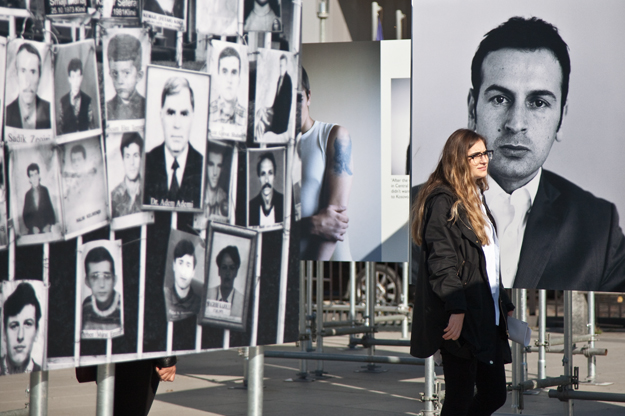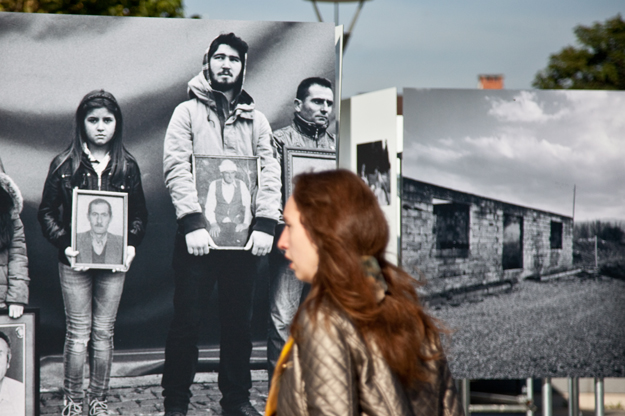After five years spent documenting the stories of Kosovars, Willem Poelstra returned to Kosovo this month to exhibit his slow photography work. In his project “For Hanna, Future Stories From the Past,” which was exhibited in the center of Prishtina, the Dutch documentary photographer depicted the impact of the Kosovo war on the lives of ordinary citizens.
Huge color and black and white portraits of Kosovar Albanians and Serbs — who in one way or another are victims of the war — hooked in many passersby in Prishtina’s Skanderbeg Square during 10 rainy Autumnal days (October 7 to 16). Surrounding the portraits were raw black and white images depicting familiar events from Kosovo’s recent past, such as protests and election days.
“It is not a political statement [that the exhibition is] in front of Parliament,” Poelstra told K2.0 as his work was being installed a day before the exhibition opening. “I think this is one of the best spots in Prishtina to have it because this boulevard is one of the most spacious ones. The thing with this exhibition is that it is made to be outside and the reason for that is that it will be seen by people who don’t normally go to museums, galleries or things like that. So people who are not interested in photography see it [and when] they see the subject [they are inquisitive] — I think this is why I want it outside.”

Poelstra, whose work is mainly analog and is unedited, has spent the past four years traveling between the Netherlands and Kosovo. After such a long process of building up his work, he is highly grateful to the Kosovar locals who have helped him along the way.
“One reason is that so many people here helped me and I wanted to organize it here for them, but also for the people I photographed because those people said, ‘Yes, we want to be photographed,’” said Poelstra. “Because they said, ‘It is good that you tell our story,’ and as a documentary photographer you want to show it.”

It was a discovery in his own family’s story that triggered Poelstra to document Kosovo, transporting his past to the people of the present-day young state: In 2011, after his father’s death, while cleaning the house together with his sister, he found a box that was labelled: “For Willem.”
“I think my father leaving his box was his way [of saying], ‘I know what you are doing. I know you are a documentary photographer and you can do something with it,” said Poelstra.
The box contained historical documents and pictures that revealed his father, Albert, spent four years during WW II working voluntarily at a locomotive company in Berlin that transported Jews to concentration camps. He also found the written genealogy of his mother, Hanna, who had died several years earlier: Following its traces he discovered that almost all of his mother’s family had been killed in Nazi-occupied Germany. His grandmother lost her four sisters during the war, and 93 family members in total.
“I knew little about it,” Poelstra told K2.0, recalling that his parents lived happily together and that the past rarely came up in family conversations. “Just imagine when, two years after the war and after working for four years in Germany, you are dating a Jewish girl; so I understood that my grandmother never liked my father, she was never happy with it. My grandmother was aware but there wasn’t much family left of course. And the thing is they never spoke about it.”
One year after Poelstra’s father’s death, Amsterdam’s Breda Photo Festival announced its theme for that year as ‘empathy.’ Festival curators liked the story of Poelstra’s parents and asked him to make a story.
“I had the story, pictures, documents and everything [of my parents]. But I wanted to make new pictures,” he said. “[I thought], ‘I cannot go back to history’ [so] intuition made me talk about Kosovo because here in Kosovo families are still opposite each other. When the ’90s happened in the former Yugoslavia … I was always struck by the fact that people were friends and suddenly everything was sort of blown away. So I found many similarities [with my own family situation] here and that’s why I went on to finish the project.”
The exhibition of his first set of photos from Kosovo at Breda 2012, “For Hanna, Future Stories From the Past,” ended up forming the first part of a wider project; he subsequently returned to Kosovo to continue with his documentation of the aftermath of the war.
Photography calling
Poelstra’s career in photography came as a result of a twist of fate. In 2000 he fell from the balcony of his house and broke his back in three places. After a long and varied career as a professional diver, an operational manager in the oil and gas industry, and latterly in communications, Poelstra’s recovery process required him to take a step back from the day-to-day exertions of his previous work.
One day he watched a documentary about a famous Indian photographer, Raghu Rai, which inspired him to switch his path and pursue photography. “I found it so cool, the way he works, and I thought maybe I should do that,” recalled Poelstra. “The very same day, in the afternoon, I checked it all out on the internet and booked myself onto a sort of probation course, happening three months later, to see if I was talented enough. I went back to school which is not easy, particularly when you are older.”
In 2005 he graduated with a bachelor’s from the Academy of Photography in Amsterdam with his first series of photos, on the Amsterdam Ambulance Service. The series, shown in various magazines, was published in book form in 2008 by Schilt Publishing, followed by a solo exhibition in the Melkweg Gallery in Amsterdam.
“I think you also need a [bit of] luck,” he reflected. “In my last six months, for the exams, I managed to get into an ambulance and in the end I did a project on the ambulance [service] in Amsterdam and I used it as my final theme for the exams. And when I exposed it in the exams, one of the largest magazines in the Netherlands called me the next day and said, ‘We want this feature in our magazine because we haven’t seen it before.’”
Poelstra travelled in an ambulance 75 times, for eight-hour day and night shifts. Although medical staff helped him a lot during the recovery from his back injuries, after a couple of visits he decided to photograph the ambulance through the experience of patients. At the end of the project, Amsterdam City Archives bought 18 of his photographs. “They told me that they had never seen the pain captured like this,” he recalled.
For these and other black and white documentary photos, Poelstra is a four time winner of the SIlver Camera award — the Dutch journalists’ award for documentary photography.
Returning to Kosovo
Poelstra puts much of his success down to the “luck” of working with a “great team” as much of his work is conducted with the input of others: assistants, writers, historians, designers or anthropologists.
“I work with scientists to get my background … to get my information, which should be correct as well,” said Poelstra, pointing towards his team, which was in the process of revealing a portrait of a young man with a scarf around his neck. “That is Nikola, a Serb from North Mitrovica who has throat cancer as a result of uranium depletion used by Nato during bombing,” he explained, adding that North Mitrovica was the first place he visited in Kosovo in 2012.
Although he works with a large group of people during exhibition preparation, he prefers to be on his own during his research. He doesn’t contact local journalists or fixers who would help to meet people or arrange meetings.
“Journalists do their work and I do mine. So I work with people, like Ereblina [Elezaj] who helps me a lot, who came to my presentation at Dit’ e Nat’ and I thought she looks like a person who can fix a lot of things,” he said, recalling meeting the young Kosovar woman for the first time. “And I just asked her, ‘Can I have a coffee with you?’ and she is still helping and that’s nice; and people introduce you to others, and so people help you and the reason people help is that they want to tell the story too.”
Between 2012 and 2016 Poelstra was in Kosovo eight times, sometimes for up to two months, during which time he visited various cities and villages from north to south. He would go to an unfamiliar town, talk to regular people, listen to their experiences, lives and stories and find those who he wanted to photograph.

“The way I work is, I don’t just look at somebody and decide if that person is very photogenic. No, I hear the story and then I think, ‘This is a story that fits into my project, and it’s up to me if I can take a picture,’” he said. “The second question would be: ‘Can I photograph that person?’ It takes a lot of courage for somebody to let you photograph them.”
By the end of the project, Poelstra had managed to document the story of a couple who fought together in the Kosovo Liberation Army, couples from mixed marriages, persons with lifelong bodily injuries as a result of war, families of missing people and people displaced as a result of war and shifting power relations.
“Basically everybody is, of course, a victim,” said Poelstra. “And I think it is [ordinary] people that are victims and I know the political situation here, and I don’t want to go into that political situation — it is not up to me. But I would like to tell the stories of the people. And it is up to everybody how they see it.”
Poelstra’ exhibition portrayed a wide range of experiences that are part of the collective memory of Kosovar Albanians and Serbs: Albanian and Serbian monuments and symbols are juxtaposed with each other, and portraits of people are juxtaposed with gloomy nature, graveyards and streets.

He points out that the use of contrasts is part of his artistic expression and not an intention to balance the experiences of two sides. “I do like contrasts and it is up to people … if you look at a picture and I look at a picture then you have a different connotation,” he said. “[There will be] different reactions because it depends on what your background is, what your history is.”
As with his parents, Poelstra noticed that people do not talk much about the past, the war and their war-related traumas — harsh experiences tend to be swept beneath the carpet within the family circle.
“I think it is very difficult … there is no talk about it,” he said. “So I believe if you want to get to your trauma, you have to expose it, you have to discuss it in order to move on.”
Poelstra is planning to set up a foundation, to preserve his work but also to help photographers, writers and journalists who want to undertake slow photography or journalism work that requires a team of people and long-term research. “Projects [like this] cost a lot of money but the media doesn’t want to pay for it so you always have to fund them using your own money, and that’s why it’s good to set up a foundation and do the kinds of projects that we do,” Poelstra said.
Meanwhile, Poelstra’s audience might soon be able to get their hands on a book that he is preparing with all the pictures he took in Kosovo and wasn’t able to showcase in his exhibition.K
Photo: Majlinda Hoxha / K2.0





